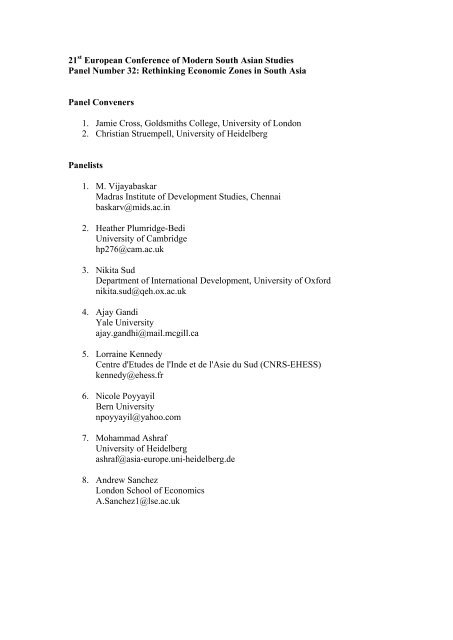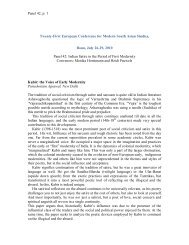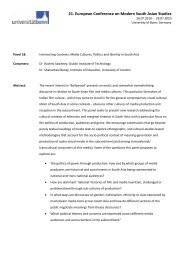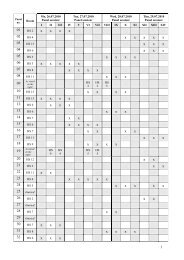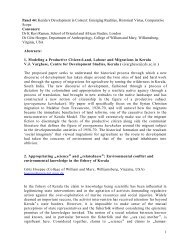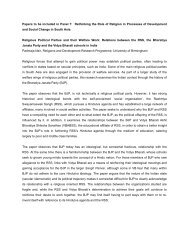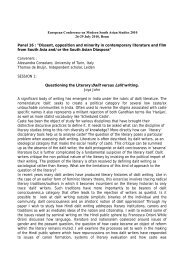Final Panel Abstracts
Final Panel Abstracts
Final Panel Abstracts
You also want an ePaper? Increase the reach of your titles
YUMPU automatically turns print PDFs into web optimized ePapers that Google loves.
21 st European Conference of Modern South Asian Studies<br />
<strong>Panel</strong> Number 32: Rethinking Economic Zones in South Asia<br />
<strong>Panel</strong> Conveners<br />
1. Jamie Cross, Goldsmiths College, University of London<br />
2. Christian Struempell, University of Heidelberg<br />
<strong>Panel</strong>ists<br />
1. M. Vijayabaskar<br />
Madras Institute of Development Studies, Chennai<br />
baskarv@mids.ac.in<br />
2. Heather Plumridge-Bedi<br />
University of Cambridge<br />
hp276@cam.ac.uk<br />
3. Nikita Sud<br />
Department of International Development, University of Oxford<br />
nikita.sud@qeh.ox.ac.uk<br />
4. Ajay Gandi<br />
Yale University<br />
ajay.gandhi@mail.mcgill.ca<br />
5. Lorraine Kennedy<br />
Centre d'Etudes de l'Inde et de l'Asie du Sud (CNRS-EHESS)<br />
kennedy@ehess.fr<br />
6. Nicole Poyyayil<br />
Bern University<br />
npoyyayil@yahoo.com<br />
7. Mohammad Ashraf<br />
University of Heidelberg<br />
ashraf@asia-europe.uni-heidelberg.de<br />
8. Andrew Sanchez<br />
London School of Economics<br />
A.Sanchez1@lse.ac.uk
<strong>Abstracts</strong><br />
1. Land Acquisition, Politics and the Governance of Dissent in Tamil Nadu<br />
M. Vijayabaskar<br />
The differential responses to the implementation of Special Economic Zones (SEZs)<br />
across states in India offer an opening to understand how policy implementation gets<br />
shaped by regional political economy. Despite being home to a large number of SEZs,<br />
Tamil Nadu (TN) has been one state which has not witnessed resistance to SEZs in<br />
general and land acquisition in particular on a scale comparable to states with a<br />
similar history of SEZ promotion. In this paper, largely based on detailed interviews<br />
with a range of actors- local and state level bureaucrats, local political leaders, elected<br />
representatives, and dispossessed farmers across different sites of land acquiaition for<br />
SEZ in the state, I offer a set of plausible explanations rooted in a synthesis of<br />
regional political economy and state level governance routines. First, I point out that<br />
the crises that has set in tubewell based agriculture has fostered a set of clear<br />
economic reasons for the ‘willingness’ of farmers to give up their land and move<br />
away from agriculture. This willingness is also partly conditioned by the long history<br />
of anti-caste politics of the state, which sees the rural as a site of oppression, and has<br />
simultaneously opened up more avenues for social mobility partly through state<br />
action. Further, the government has used its ‘success’ in drawing investments to<br />
validate its policy of SEZ promotion. This ‘willingness’ has also been enabled by<br />
state level policy changes. Policies ensure compensation closer to market prices for<br />
land acquired, while land owners face powerful incentives to avoid legal contestation.<br />
I map the process of production of ‘consent’ and setting up of prices in a couple of<br />
sites to illustrate the role of bureaucratic routines and local political negotiations in<br />
this process. The exercise also contributes to our understanding of how regional<br />
‘industrial orders’ emerge out of policy interactions with local structures and<br />
agencies. <strong>Final</strong>ly, a recovery of such local trajectories and influences is important for<br />
any broader political mobilization undertaken along larger spatial scales.<br />
2. Power, Land and Justice: Social movement resistance to Special Economic<br />
Zones in India<br />
Heather Plumridge Bedi<br />
Underlying social movement organising around industrialisation and development<br />
issues in India are concerns about land, social inequity, and environmental justice.<br />
Across India communities, social movements and others are mobilising against what<br />
some describe as pressures associated with market liberalisation. In particular, the<br />
Indian government, in conjunction with corporations, has encouraged industrialisation<br />
in the form of Special Economic Zones (SEZs). SEZs in turn have led to massive land<br />
acquisitions, displacement, and a range of environmental ramifications. The growing<br />
nexus between private companies and the state has created a “hybrid animal”<br />
(interview 126, March 13, 2009) that has created confusion among some communities<br />
and movements regarding the most efficacious form of resistance.<br />
Drawing from empirical research, this paper analyses how social movements<br />
have protested against SEZs, including how they have framed the challenges<br />
associated with land governance and justice concerns. In particular, the paper will
question notions of social power among actors with unequal standing, including<br />
struggles who may be perceived as lacking power (O’Neill 2008). This example<br />
illuminates how movements deemed the proposal of SEZs to be unjust, and felt<br />
subordinated by the state government. Using resistance discourses of land and<br />
governance justice, the movements successfully changed state level policy on SEZs<br />
and thus challenged conventional ideas about power and voice. Through these actions,<br />
the movements appropriated space to define what is equitable and just in their context,<br />
and transformed a local civil society discourse against a powerful agent of power<br />
(Chandoke 2003).<br />
3. Spaces of neo-liberalism and the good governance agenda<br />
Nikita Sud<br />
According to the World Bank (2008), public governance becomes ‘good’ when it<br />
involves voice and accountability, predictability, political stability and peace,<br />
effective government, the rule of law, regulation of the market and the control of<br />
corruption. A network of institutions ranging from civil and political society to the<br />
market, judiciary and bureaucracy are to be involved in the good governance<br />
endeavour. Spaces occupied by the neo-liberal economy- typified by SEZs- are<br />
founded on expectations of this new form of governance. Indeed India’s state appears<br />
to be re-moulding itself in order to service the new economy (Sud 2009). But how<br />
actually is the new regime of governance playing out on the ground? My paper will<br />
attempt to answer this question based on field research in Gujarat- a frontrunner in<br />
liberalisation that prides itself as the ‘number one State for governance in India’.<br />
Investigation of an SEZ in the making in Gujarat evinces legislation being modified to<br />
suit specific private players in a market-distorting manner that is neither accountable<br />
nor transparent. Engagement with civil society is at the level of its neutralisation- with<br />
protesters being bought off or brutally suppressed. Casualised labour is being crushed,<br />
local livelihoods uprooted and the natural environment severely abused, with little<br />
regard to the law or established regulatory mechanisms. In short, contemporary spaces<br />
of neo-liberalism are being built through a close collaboration between the state and<br />
market- but the kind of governance on display is anything but ‘good’. Perhaps this is<br />
to be expected. Good governance modelled on a matrix of institutional collaboration<br />
implies stability and coherence (Leftwich 2000). On the other hand, the development<br />
that is being aimed at in spaces of neo-liberalism is inherently unstable, fast paced and<br />
result oriented. Any expectation of good governance is merely ‘a triumph of<br />
concealment’ (Abrams 1988: 77) and an exercise in legitimacy gathering for the<br />
unfolding neo-liberal project. This project is likely to continue thriving on crony<br />
capitalist, convenient governance.<br />
4. The Logic of the Bazaar in Old Delhi<br />
Ajay Gandhi<br />
The British, in crafting a colonial economy, often perpetuated rather than radically<br />
breaking with pre-existing urban sites of commerce in South Asia. The bazaar (like<br />
the souk in the Middle East), with its unplanned and associational character, was<br />
interwoven with industrial sites of manufacture and extraction and highly regimented<br />
forms of labour-control (the jute mills or indigo factories, for example). It is striking
that many South Asian cities still have older quarters, sometimes around their precolonial<br />
nodes, in which a significant volume of economic trade for surrounding<br />
regions is transacted. Delhi’s old city, for example, contains many wholesale bazaars,<br />
processing items such as pharmaceutical drugs, plumbing equipment and wholesale<br />
cloth, which comprise a significant portion of the entire trade for that commodity<br />
throughout northern India. Most of these bazaars have developed in a highly<br />
improvised, illicit way, flouting urban planning regulations and openly trafficking in<br />
counterfeit and adulterated goods. For this reason, the urban bazaar is, in the postcolonial<br />
period, often seen by authorities as a murky, illegal space of floating<br />
populations and black profiteering.<br />
Yet the economic dynamism of such bazaars throughout the region has not<br />
diminished, despite the past decade's development of Special Economic Zones (SEZ),<br />
and integrated, multinational-led manufacturing and transportation hubs. The Indian<br />
bazaar, in this sense, is counterfactual to the notion that neo-liberalism has meant a<br />
transition from the bazaar to the shopping mall, or from manual work to intellectual<br />
work (as per conventional narratives of the rise of information technology and the<br />
service sector). And bazaars, illegible and parochial though they often seem, are<br />
interconnected with transnational capital flows and global trade (through hawala<br />
transactions and pilgrim cycles, for example) in ways that precede the official start of<br />
globalization. Thus urban planning and rationalization has not been able to extinguish<br />
such spaces in favour of more modern, self-contained spaces (the privatized shopping<br />
mall, the self-enclosed information technology park, the heavily policed SEZ).<br />
Arguably, without the maintenance of seemingly antiquated forms of labour control,<br />
brokership and patronage embodied in the bazaar, the circulation of many goods in<br />
South Asia would become impossible (the failure of many recent attempts to<br />
vertically integrate food and produce procurement and retailing in urban centers in<br />
India shows this).<br />
Why, then, is the South Asian bazaar persistently central to the life of cities,<br />
and how does it frustrate attempts at rationalization? Drawing from ethnographic<br />
research in Old Delhi, this paper attempts a tentative answer to this question, by<br />
detailing the connivance of official parties and local interests in stalling economic<br />
modernization, in different forms: safety regulations, Master Plan "regularization",<br />
and the removal of entire bazaars to dedicated, sanitized compounds elsewhere in<br />
Delhi. The paper argues that the contemporary SEZ, mall, and multinational industrial<br />
corridor in India attempts to segregate social activities (work, housing), instantiate<br />
forms of labour discipline, and transform city planning in ways that are actually<br />
dependent on, and interface quite naturally with, informal or protean or illegal forms<br />
of economic commerce, like those found in the ubiquitous bazaars of Old Delhi. In<br />
this way, the neo-liberal modernization of trade in India is not a radical historical<br />
rupture, but rather depends on the very informal economic activity it promises to<br />
displace.<br />
5. Large Scale Economic and Infrastructure Projects in India’s Metropolitan<br />
Cities: New Policies and Practices Among Competing Sub-national States.<br />
Lorraine Kennedy<br />
Engaging with theory from the field of international political economy and political<br />
geography, this paper undertakes to critically examine the strategies of increasingly<br />
powerful subnational political actors in India and to discuss their emerging role in the
territorial restructuring process. The analysis focuses on the politics and policies of<br />
the re-scaling process underway within the national political economy, which are<br />
being played out in the framework of India’s distinct federal system. Taking largescale<br />
economic and infrastructure projects as emblematic examples, I examine the<br />
policies of the State of Haryana, which are shaping the metropolitan region of Delhi.<br />
6. Respatialisation of Citizenship: The construction of Special Economic<br />
Zones (SEZs) in Maharashtra’s Raigad district<br />
Nicole Poyyayil<br />
No scheme of the Indian Government has evoked as much debate and controversy in<br />
recent years as the introduction of the Special Economic Zone (SEZ) scheme, aimed<br />
at promoting export oriented growth in the country. The paper focuses on the<br />
proposed Navi Mumbai SEZ (NMSEZ) and Maha Mumbai SEZ (MMSEZ) located in<br />
Maharashtra’s Raigad district, in close proximity to Central Mumbai and the planned<br />
city of Navi Mumbai. Raigad district is presently undergoing rapid spatial<br />
transformation that crucially restructures socio-spatial settings due to the upcoming<br />
SEZs and related infrastructure developments. The NMSEZ is presented by its<br />
promoter - the state government owned City and Industrial Development Corporation<br />
(CIDCO) - as “India’s best positioned SEZ” and is declared an industrial township<br />
which enables it to function as a self-governing, quasi-autonomous municipal body.<br />
The paper addresses the processes of socio-spatial change and the emerging issues in<br />
the context of the upcoming NMSEZ and MMSEZ, respectively, and considers space<br />
thereby not as a “neutral grid” but rather as a dynamic concept, dialectically<br />
interlinked with contemporary socio-economic and socio-political complexities. In the<br />
above context, the paper focuses on the respatialisation of citizenship, the SEZ policy<br />
as an example of an inherently spatial post-reform policy and its anticipated as well as<br />
unanticipated effects -such as forms of inclusions and exclusions- as well as on spatial<br />
governmentality as a contemporary form of restructuring socio-spatial relations based<br />
on particular visions of growth, development and social wellbeing<br />
7. Market-oriented modes of governance and neoliberal subjectivity in<br />
Bangladesh Export Processing Zones (EPZs): an anthropological perspective<br />
Mohammad Ashraf<br />
This paper intends to locate and analyze the establishment of EPZs in Bangladesh in<br />
the historical context of the country’s gradual turn towards neoliberal policies from<br />
the 1970s onwards. Immediately after independence in 1972 the first industrial policy<br />
steps taken by Bangladesh government was the nationalization of large and medium<br />
scale industries. It was only after the military coup that the state altered its approach<br />
to industrial development. In 1980 the Foreign Private Investment (Promotion and<br />
Protection) Act was implemented opening the country for foreign capital. Directly<br />
building upon this act in 1983 the Bangladesh Export Processing Zones Authority<br />
(BEPZA) was established to promote, attract and facilitate foreign investment in the<br />
EPZs. Consequently, following all these events textile industries in EPZs and outside<br />
EPZs (known as Bangla Garments) boomed in mid 1980s and expanding since then<br />
and has become the source of main export earnings. BEPZA has established eight<br />
EPZs in the country so far and Bangladesh is now the sixth largest exporter of
eadymade garments products for the world market with a labour force of 3 million<br />
workers, the large majority of whom are young rural women. The key questions my<br />
paper will address are: (i) How do state visions and practices relate to the global<br />
spread of neoliberalism as it was mediated through multilateral actors from the late<br />
1970s onwards. (ii) What effects did the neoliberal turn have on the relationship<br />
between the postcolonial state and its citizenry, on a national as well as local level of<br />
analysis. (iii) what subjectivities did emerge within the labour force in active response<br />
to these visions and practices and in what ways are they specific to it.<br />
8. Pocket Unions and Splinter Unions: The Decline of Collective Action in an<br />
Indian Company Town<br />
Andrew Sanchez<br />
The Tata company town of Jamshedpur occupies an iconic place in Indian history,<br />
being the site of South Asia’s first steel mill. Jamshedpur furthermore claims a pivotal<br />
role in the development of Indian labour relations, with the Tata Workers’ Union<br />
being the founder member of the Indian National Trade Union Congress. For the<br />
present generation of Tata company workers, the historical security of a lifetime’s<br />
employment, and the right to company housing, healthcare and education that it<br />
brings are now unattainable goals. In response to the demands of economic<br />
liberalisation, the previous decade has seen the majority of the city’s Tata workforce<br />
casualised; a process that reduces the wages of many workers to a fraction of former<br />
levels, as well as radically transforming the company’s civic role.<br />
With an increasingly smaller proportion of the Tata workforce is eligible to<br />
join the Tata Workers’ Union, and a pervasive popular assumption of union<br />
corruption, this paper discusses the shifting patterns of collective action in<br />
Jamshedpur during casualisation. Distinct from their historical ideology of class<br />
struggle, the Tata Workers’ Union have recently engaged in a neo-liberal re-reading<br />
of their role. Through a language of ‘joint consultation’, the union places value upon<br />
harmonious relations with management, and the stabilising of the production process.<br />
This paper contrasts this conservative trade unionism against more politically<br />
motivated ‘Splinter Unions’ in Jamshedpur; discussing the declining efficacy of both<br />
forms of collective action during the casualisation process.


